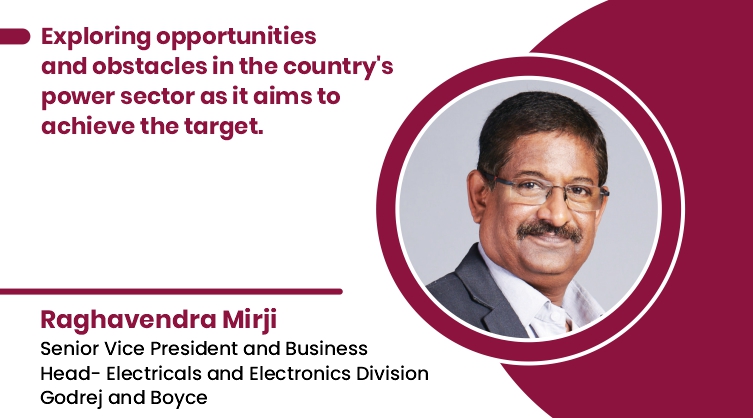The shift to clean energy underscores the need for reliable, efficient equipment
By EPR Magazine Editorial November 2, 2023 6:09 pm IST
By EPR Magazine Editorial November 2, 2023 6:09 pm IST

Exploring opportunities and obstacles in the country’s power sector as it aims to achieve the target.
India’s ambitious goal of achieving a $5 trillion economy in the coming years hinges significantly on the growth and stability of its energy and power sector. As the backbone of economic development, a robust and reliable power infrastructure is crucial to support this ambitious target. In this article, Raghavendra Mirji explores the challenges and opportunities in India’s energy sector, focusing on the role of government initiatives, clean energy transition, and the importance of workforce development.
The current state of power sector
Over the years, India’s power sector has witnessed substantial progress, transitioning from a struggle to meet electricity demands to a surplus in power generation. This transformation is an essential foundation for the country’s economic growth. In recent months, India recorded its highest-ever power demand without experiencing any blackouts, showcasing the readiness of the power infrastructure to cater to growing needs.
Electrifying rural India
One significant achievement has been the electrification of rural areas. Government schemes like the Deen Dayal Upadhyaya Gram Jyoti Yojana and Rajiv Gandhi Grameen Vidyutikaran Yojana have successfully connected rural households to the electricity grid, providing them with the basic necessity of electricity. While this is a crucial step, there is still a long way to go in terms of bridging the urban-rural divide in terms of the facilities and amenities available.
Challenges in the power sector
India’s power generation heavily relies on fossil fuels, including oil, gas, and coal. The dependence on imported fossil fuels makes the country vulnerable to supply disruptions and price fluctuations. To ensure energy security, India must prioritise developing alternative and clean energy sources, such as green hydrogen, solar, wind, and hybrid systems. The goal is to generate 60 percent of total energy from renewable sources by 2030, as stated by India’s commitment to the global climate agenda.While the transition to clean energy sources is essential, India faces challenges in seamlessly integrating renewable energy into the grid. Technology must evolve further to ensure a smoother transition from fossil fuel-based power to clean energy. Issues such as grid integration, resource availability, and incomplete technology deployment are teething problems that require attention and policy support.
A critical challenge in the power sector is the need for more skilled labour and specialised expertise. Despite the employment issues faced by the country, there is a significant gap in terms of the skill sets required for the power sector. To bridge this gap, both the industry and the government must collaborate to develop robust skill development programs and initiatives that cater to the sector’s specialised needs.
Opportunities in the power sector
The transition to clean energy in India’s power sector presents substantial investment opportunities, focusing on achieving 500 gigawatts of renewable energy by 2030. This shift emphasises the need for efficient and reliable equipment, including transformers, circuit breakers, and isolators, to enhance power stability and reliability. Smart grid technology adoption is rising to address power supply fluctuations, enabling efficient load balancing and reducing the risk of blackouts.
Rural infrastructure development is a priority, involving the upgrade of transmission networks and the deployment of microgrids powered by solar and wind energy in hard-to-reach areas. However, land availability remains challenging for solar power projects, prompting a reliance on imported solar panels and affecting project costs. Addressing land availability issues and bolstering domestic solar panel production is essential for the sustainable growth of the solar sector. Overall, the Indian power sector’s evolution toward renewable energy and modernised equipment offers ample investment prospects while addressing critical energy needs nationwide.
Spokesperson: Raghavendra Mirji, Senior Vice President and Business Head- Electricals and Electronics Division- Godrej and Boyce
We use cookies to personalize your experience. By continuing to visit this website you agree to our Terms & Conditions, Privacy Policy and Cookie Policy.